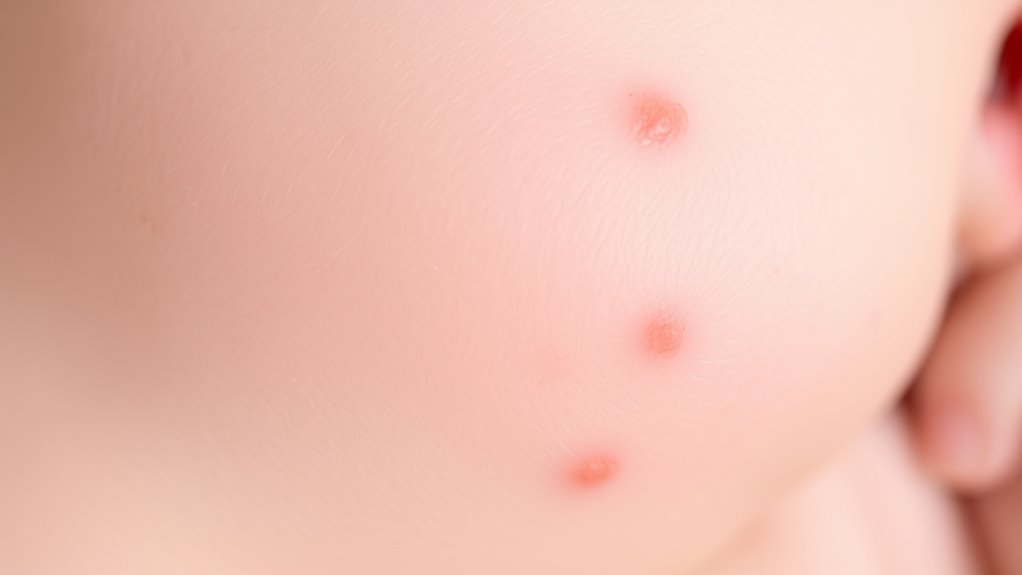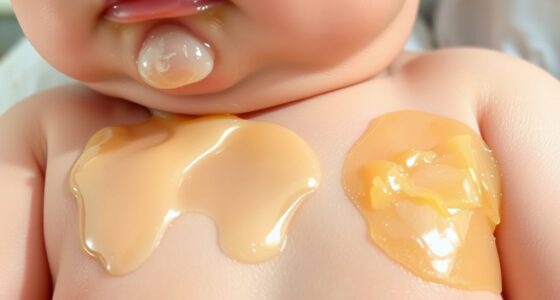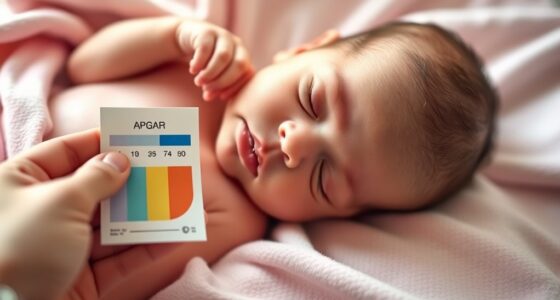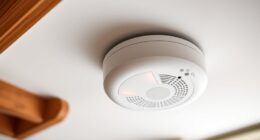Newborn rashes are common and usually harmless, happening as their skin matures. You might notice diaper dermatitis, which causes redness and irritation in the diaper area, or milia, small white bumps on their face that often clear up on their own. These rashes are typically caused by moisture, skin sensitivity, or skin immaturity. Most improve with simple care like frequent diaper changes and gentle cleaning—continue further to learn how to tell normal rashes from signs needing medical attention.
Key Takeaways
- Most newborn rashes, like milia and diaper dermatitis, are harmless and resolve without treatment.
- Diaper rash is caused by prolonged moisture, irritation, or skin sensitivity, and improves with proper care.
- Milia are tiny bumps on the face due to skin immaturity, usually clearing up in a few weeks without intervention.
- Gentle cleaning, frequent diaper changes, and barrier creams help manage common rashes effectively.
- Seek medical advice if rashes worsen, spread, or are accompanied by symptoms like fever or pus.
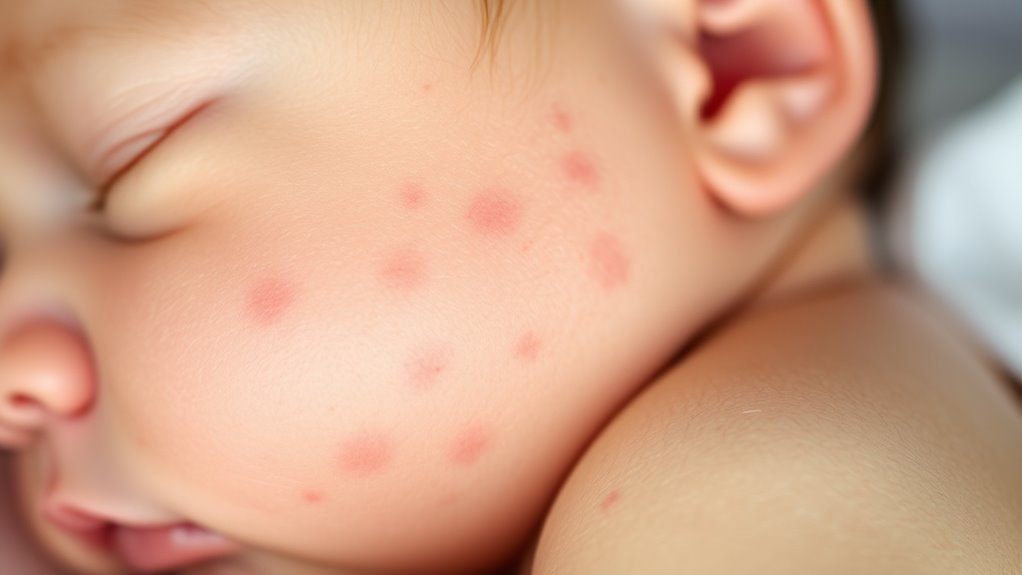
Newborn rashes are common and usually harmless, but they can be worrying for new parents. One of the most frequent skin issues you might notice is diaper dermatitis, which appears as redness, irritation, or even small bumps around your baby’s diaper area. This rash often results from prolonged exposure to moisture, irritants like urine and stool, or chafing from diaper friction. It’s natural to feel concerned, but keep in mind that diaper dermatitis is a normal part of infancy and tends to resolve quickly with proper care. Changing diapers frequently, gently cleansing the area with water, and allowing it to air out can help soothe the rash and promote healing. Using barrier creams containing zinc oxide or petroleum jelly creates a protective layer, preventing further irritation.
Diaper dermatitis is common, harmless, and easily managed with proper skin care and frequent diaper changes.
Alongside diaper dermatitis, you might also notice milia formation on your newborn’s face. Milia are tiny white or yellowish bumps that typically appear on the nose, cheeks, or chin. They occur when dead skin cells get trapped in small pockets beneath the skin’s surface, often due to the skin’s immaturity at birth. Milia are very common and harmless, and they usually clear up on their own within a few weeks without any treatment. You don’t need to pick or squeeze them, as that can cause irritation or infection. Instead, keep your baby’s skin clean and avoid harsh creams or lotions, which can sometimes worsen the situation. Gently cleansing the face with a soft cloth and using mild, fragrance-free products can help keep the skin healthy. Recognizing that newborn skin is still developing can help you understand why these rashes occur and reassure you that they are temporary.
It’s important to remember that many newborn rashes, including diaper dermatitis and milia, are signs of your baby’s skin adjusting to life outside the womb. While they might look uncomfortable or concerning, these conditions rarely require medical intervention. However, if your baby’s rash worsens, spreads beyond the diaper area, or is accompanied by other symptoms like fever or pus, you should consult your pediatrician promptly. Sometimes, rashes can be signs of infections or other skin conditions that need specific treatment. But most of the time, these rashes are just temporary phases that will improve with simple home care.
Understanding that most newborn rashes are harmless can help ease your worries and allow you to focus on caring for your new arrival. Keeping your baby’s skin clean, dry, and protected is the best approach to managing common issues like diaper dermatitis and milia. Remember, patience is key—your baby’s skin is still developing, and these tiny bumps and redness will fade with time. Trust your instincts, and don’t hesitate to seek advice from your healthcare provider if you have any concerns.
Frequently Asked Questions
When Should I See a Doctor for a Newborn Rash?
You should see a doctor if your newborn’s rash causes swelling, blistering, or bleeding, or if it’s spreading rapidly. Also, seek medical advice if the rash is accompanied by fever, fussiness, or difficulty feeding. While most rashes are harmless, understanding rash causes and maintaining proper skin care can help. Trust your instincts—if something doesn’t seem right, consulting a healthcare professional guarantees your baby’s safety and well-being.
Can Newborn Rashes Indicate a Serious Health Issue?
You might worry that a rash signals a serious health issue, but most are harmless. However, skin irritation and allergic reactions can sometimes indicate underlying problems. If your newborn’s rash is accompanied by swelling, difficulty breathing, fever, or spreads rapidly, it could be a sign of something more serious. Always trust your instincts and consult a doctor if you’re concerned, especially if symptoms worsen or don’t improve.
Are Certain Foods or Products Causing My Baby’s Rash?
Yes, certain foods or products can cause your baby’s rash. Food sensitivities might trigger skin reactions, especially if you’ve recently introduced new foods. Skin irritants like harsh soaps, detergents, or lotions could also be culprits. Pay close attention to any changes in your baby’s diet or skincare routine, and consult your pediatrician if you suspect a specific food or product is causing the rash.
How Can I Differentiate Between Harmless and Concerning Rashes?
Like a detective solving a mystery, you can differentiate harmless rashes from concerning ones by observing rash color and pattern. A harmless rash typically appears pink or red, with a diffuse, even pattern. If the rash is blistering, spreading quickly, or accompanied by swelling, fever, or difficulty breathing, it’s time to seek medical attention. Trust your instincts—any sudden changes or unusual symptoms warrant prompt evaluation.
Do Newborn Rashes Require Any Special Treatment or Medication?
Most newborn rashes don’t need medication and can be managed with simple home remedies like gentle bathing and keeping the skin dry. You usually don’t need to seek medication unless the rash worsens, spreads, or is accompanied by other symptoms like fever or irritability. If you’re unsure, it’s best to consult your pediatrician before applying any treatment, ensuring your baby’s comfort and safety.
Conclusion
Remember, these rashes are like passing clouds in your baby’s sky—temporary and harmless. As you watch over your little one, know that most of these skin quirks fade away like dawn’s first light, revealing smooth, peaceful skin underneath. Trust your instincts and know that gentle care and patience are your guiding stars. Soon, your baby’s skin will shine bright again, a clear canvas of health and happiness, ready for new adventures ahead.
